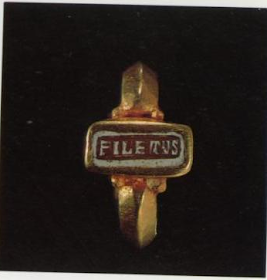The doll belonged
to a young woman named Crepereia Tryphaena who lived in Rome in the second
century. She was engaged to be married but had the sad fate of dying just
before her wedding at the age of 20. She was buried on the bank of the river
Tiber in a marble sarcophagus which was discovered and opened in 1889 when the
Hall of Justice was being built. Alongside the girl in the sarcophagus was an
ivory doll, probably with a symbolic function. At the time, custom was for
brides-to-be to sacrifice the dolls from their childhood to Venus, the goddess
of love and beauty, on their wedding day to symbolize the entering into the
life of a wife and that their virginity would end. Poor Crepereia Tryphaena,
she never completed the Venus sacrifice, instead the doll joined her mistress
in the grave. Today, the ancient doll is kept in the Musei Capitolini in Rome
but is not on display. It is of extraordinary artistic and handcrafted quality
and was probably dressed in clothes, but these have disintegrated over the
years. Her hair style is according to common hair-does in Rome in the second
century AD.
Στο
Μουσείο Capitolini στην Ρώμη,
υπάρχουν μεταξύ των εκθεμάτων και αρκετά ευρήματα από παιδικούς τάφους, τα
οποία περιλαμβάνουν όμορφα κοσμήματα με πολύτιμους λίθους και παιχνίδια.
Ανάμεσα σ΄αυτά υπάρχει και μια κούκλα από ελεφαντόδοντο, μαυρισμένη από τα
χρόνια, τόσο που κάποιοι να νομίζουν πως η κούκλα είναι ξύλινη.
Η
κούκλα αυτή είναι το ομορφότερο και αρτιότερο εύρημα τέτοιου είδους που έχει
βρεθεί μέχρι σήμερα. Ανήκε σε ένα άτυχο μικρό κορίτσι, 13-14 ετών που άλλοι
αναφέρουν πως ήταν παντρεμένη επειδή έφερε στο χέρι της δαχτυλίδι με το όνομα Filetus, άλλοι πως ήταν αρραβωνιασμένη, πράγμα που
είναι και το πιο πιθανό.
Sarcofago di Crepereia
Tryphaena. In 1993 a
sarcophagus was unearthed at Vallerano on the Via Laurentina in the south of
Rome. It contained the remains of a girl of 16-18. Despite her young age, she
had been buried - in the second half of the 2nd century AD - with an
extraordinary array of exquisitely-fashioned gold necklaces, amulets, rings and
cameo brooches, set with emeralds, sapphires, diamonds, amethysts, sardonyx,
garnets and other gemstones, amber hair-pins, a large silver hand-mirror, its
back decorated with an elaborate high-relief mythological scene, and silver
scallop shell that was probably a scented-oil container. These sensational
discoveries have gone on display for the first time in 'The Mystery of a Young
Girl', an exhibition at the Accademia Valentino in Piazza Mignanelli (just off
Piazza di Spagna), accompanied by a fascinating gathering-together of previous
finds from girls' graves of the same epoch, unparalleled in their sumptuousness
by any others from the entire Roman period.
Το
κορίτσι ονομαζόταν Κρεπερέια Τρύφαινα (Crepereia Tryfaina) και ήταν Ελληνικής καταγωγής. Έζησε τον
δεύτερο μετά Χριστόν αιώνα, και ο τάφος της ανακαλύφθηκε το 1889. Η σαρκοφάγος
της βρέθηκε στον οικογενειακό τάφο, όπου είχε ταφεί και ο Εύοδος Κρεπερέιους,
ο οποίος πιθανότατα ήταν ο πατέρας της.
Edward Gibbon in 'The Decline and Fall of the Roman Empire'
proclaimed the 2nd century AD 'the period in the history of the world during
which the human race was most happy and prosperous.' And the pinnacle of this
Golden Age he placed firmly during the rules of Antoninus Pius and his adopted
son Marcus Aurelius, author of the famous 'Meditations', whose consecutive
reigns were 'possibly the only period in history in which the happiness of a
great people was the sole object of government.' These years, spanning 138-180
AD, or soon after, are those from which these unusual graves date. During this
time wars were few and conducted on the remote frontiers of the Empire, the
benefits of Roman civilization most visible, and the material well-being of
people throughout Rome's vast domains exceptionally high. Luxury goods - silks
from China, rare dyes, spices and perfumes from the East Indies, India and
Egypt - poured into Rome, provoking the contemporary historian Tacitus to
lament the disastrous drain this brought about on the state's gold reserves. The
origins of the Young Girl of Vallerano's precious stones alone offer a
revealing glimpse of how, a thousand years before Marco Polo, precious
commodities were reaching the West even from distant lands on the edges of the
known world: the diamonds in her rings, for example, can now be traced back to
India, the sapphires to Sri Lanka and the emeralds to Egypt.
Τα
κορίτσια όταν παντρεύονταν συνήθιζαν, να
αφιερώνουν τις κούκλες τους στην Αφροδίτη και έτσι σφραγιζόταν το τέλος της
παιδικής ηλικίας και το πέρασμα στην ωριμότητα. Η άτυχη αυτή νέα δεν πρόλαβε
όμως, την χαρά του γάμου της κι΄ έτσι
ετάφη με τα παιδικά της παιχνίδια, φορώντας κατά πάσα πιθανότητα το νυφικό της
φόρεμα.
Crepereia
Tryphaena's doll is especially interesting not only on account of the sensitive
carving of the facial features, but also because her hairstyle, the image of
that of Marcus Aurelius's wife Faustina, is shown in a number of
representations of the Empress, a lively leader of fashion, who was
subsequently, very likely unfairly, accused of fast living and flirtatiousness,
and of being not altogether worthy of her Stoic husband (in fact, she bore him
at least 13 children).
Η
κούκλα φέρει περίτεχνη κόμμωση όπως αυτό
των ευγενών γυναικών της εποχής με πρώτη την Faustina την σύζυγο του Μάρκου Αυρηλίου.
Έχει την
ανατομία μιας γυναίκας στην εφηβεία και φέρει οκτώ συνδέσεις στα άκρα έτσι ώστε
να εξασφαλίζεται πλαστικότητα στην κίνηση. Φυσικά ήταν ντυμένη, αλλά η
ενδυμασία της δεν διεσώθη μέχρι την μέρα της ανακάλυψής της. Εξάλλου κατά την
διάρκεια των αιώνων, ο τάφος είχε δεχθεί και τα νερά του Τίβερη.
Along with these
dolls have been found minute make-up boxes, combs and tiny mirrors, and in the
case of the Via Cassia doll, minuscule gold earrings and a wonderful miniature
measuring-spoon, pitcher and scallop shell in amber. The Tivoli doll was
recovered still wearing her gold necklace, bracelets and anklets - the last an
exotic oriental touch by Roman standards. Not the least of the 2nd century AD's
milder aspects was its new tenderness towards children and interest in their
autonomous existence, which is born witness to in the literature of the times.
Plutarch, to take but one example, an early herald of this new spirit of
sympathy, recalls how his daughter, whom he was inconsolably grief-striken to
lose at the age of two, insisted that her nurse give the child's doll milk as
well as the child herself. The evidence so far suggests that the opulent jewels
some girls were buried wearing did not have any particular religious
significance, but were treasured individual possessions. Valuable jewelry, as
far as we know, was regarded by the average Roman as an asset and hedge against
misfortune, to be passed on from generation to generation, suggesting that the
placing of so much wealth in a child's grave would have been generally regarded
as a recklessly flamboyant, even ostentatious, Eastern practice.
Η κούκλα δεν ετάφη μόνη. Την συνόδεψαν και τα υπάρχοντά της, τα οποία αποτελούνταν από δύο δαχτυλίδια, ένα εκ των οποίων έφερε ένα κλειδί με το οποίο άνοιγε μια περίτεχνη κασετίνα επίσης από ελεφαντόδοντο, με δύο κτένες στο εσωτερικό και έναν μικρό ασημένιο καθρέφτη.










Δεν υπάρχουν σχόλια:
Δημοσίευση σχολίου